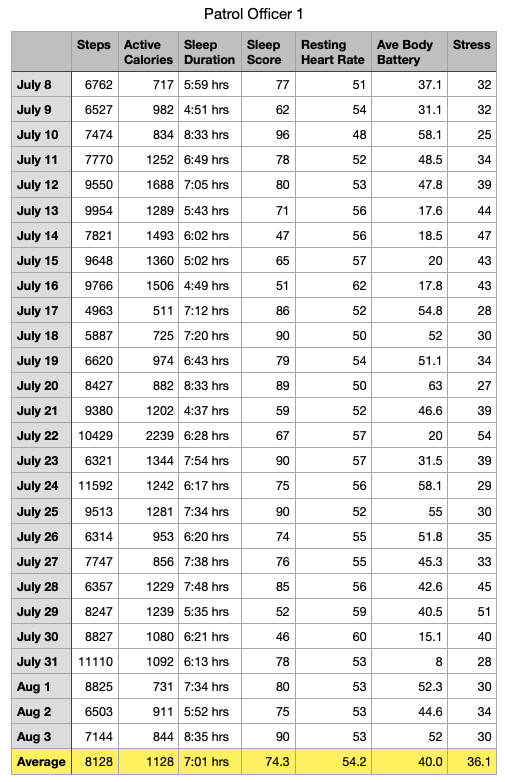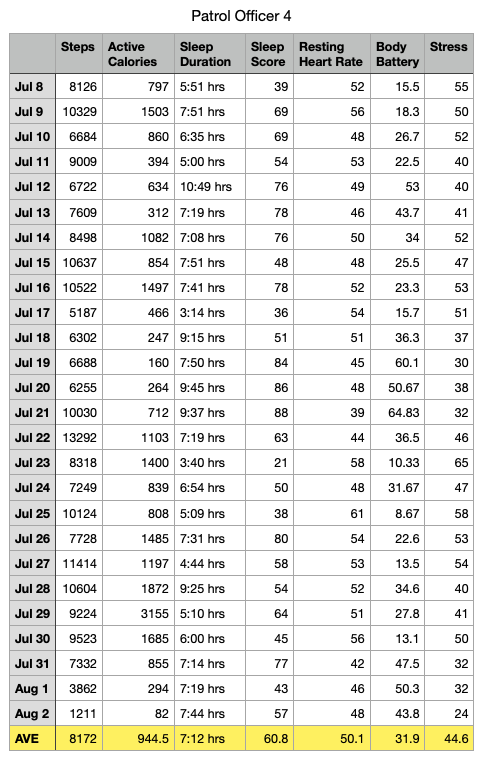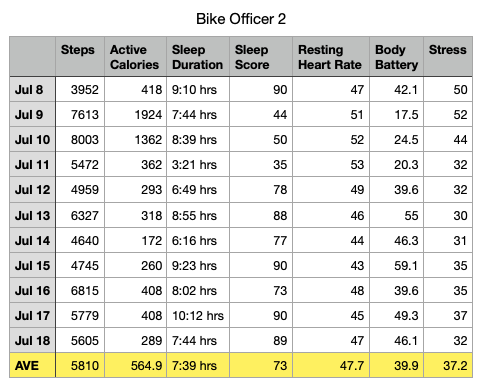
By Rob Shaul, Founder
BLUF
This Mini Study sought to give a snapshot point in time view into sleep patterns, activity and stress levels of full time Patrol and Bike Police Officers employed by a small US City.
The results found that the Patrol and Bike officers in this city averaged just over 7 hours sleep per night, averaged surprisingly low stress levels, and have moderate energy levels on a day to day basis.
Background and Study Design
Years ago at a programming course for local law enforcement, I was asked by one of the officers for ways to conduct a study on the day-to-day stress levels of patrol officers. This was a few years before modern wearable technology was developed, but I filed the idea away.
Other research has conducted similar work, however, surveys have been used to collect data and then interpreted to assess findings. Written surveys are a fairly intrusive data collection method, which can be swayed significantly by interview questions, participant interest, etc.
In the years since, multiple wearable health and fitness technology and devices have been developed which offer a much less intrusive, and possibly, more accurate method, of collecting sleep, activity and stress data.
For this study, MTI partnered with 20 Patrol and Bike officers in a small US City. MTI purchased twenty, Garmin Instinct 2 Solar watches and distributed them to these officers in early July, 2023..
After a week of familiarization, the hope was that the officer would wear the devices for 2-4 weeks, and upload their individual data to the Garmin Connect website.
Garmin Instinct Solar 2 watches were chosen because of the activity, sleep and stress tracking functions, as well as ease of use. With their solar capability, these watches have fairly long battery lives, and the hope was that the officers would wear and forget about them and let the devices do their tracking.
MTI was provided with the username and password for each Officer’s Garmin Connect account, which allowed us to look at the Garmin created 2-week and 4-week reports for each individual officer.
The idea was to compile this data and analyze it for insights into Officers’s activity, sleep and stress patterns.
Results & Discussion
See Individual Officer and Overall Results Below:








Sleep Duration
Individual officer daily sleep duration ranged from under two hours, to over twelve, but the overall daily average for the 7 officers who had enough data to analyze came back with a remarkably similar average nightly sleep duration of around seven hours, the the overall average of 7:10 hours.
Sleep Score
Garmin’s Sleep Score is “calculated based on a blend of how long you slept, how well you slept, and evidence of recovery activity occurring in your autonomic nervous system derived from heart rate variability data. Here is Garmin “Sleep Score” scale:
- Excellent 90-100
- Good 80-89
- Fair 60-79
- Poor 0-60
Based on this scoring, just one of the officers, Patrol Officer 3, had an average sleep score during the study period in the “Poor” range.
Bike Officer 3, Bike Officer 2, Patrol Officer 4, Patrol Officer 2 and Patrol Officer 1 all scored in the “Fair” range, while Bike Officer 1, with an average sleep score of 85.4 scored in the “Good” range.
Overall, the quality of sleep these officers are getting is surprising, as many officers do shift work, and at all times on duty, can be “on edge” for confrontation. What it could demonstrate is a high level of stress accommodation each has acquired over the years of service. And with that comes the ability to unwind from work, and sleep relatively soundly.
Stress
According to Garmin, “stress levels (0–100) are estimated by the Firstbeat Analytics engine, primarily using a combination of HR and HRV data. This data is recorded by the optical heart rate sensor on the back of your device.” Stress measures over 50 are considered relatively high using this metric.
Based on this “50” threshold level, none of the officers in this study are significantly stressed. None of the officers recorded an average stress level of over 50.
Patrol Officer 4, with an average stress level of 44.6 for the study period, had the highest stress of the group, including the most individual days over 50, and one day, July 23, the spoke to 65.
Like sleep duration and sleep score, I was somewhat surprised by this, and expected higher levels of stress.
July 16th Incident
On July 16, two officers in one of these units experienced a shooting incident where a suspect was killed, and there was department-wide corresponding fall out. The extra stress from this incident is evident in the data most clearly by looking at sleep duration on July 16 and the days immediately afterword. Patrol Officers 1, 3 and Bike Officer 4 show short sleep durations on July 16 or shortly afterward. However, while the effect of this incident may have resulted in short sleep durations for the officers, there wasn’t a corresponding spike in stress as measured by the Garmin system.
Active Calories, Steps
Most of the officers in the study did not know, or forgot, to engage the watch for fitness tracking while doing physical training and it’s not clear if the Garmin system will recognize fitness training if the user doesn’t engage it. As a result, there wasn’t much available data from training, and it’s somewhat unclear if the “Active Calories” measure from the Garmin system includes fitness training so we’re not sure the accuracy of this measure. The “steps” measure similarly seems not very valuable. So overall, at least for this initial Mini Study we were unable to attain any reliable activity data.
Next Steps/Lessons Learned
I was disappointed in the subject attrition from this Mini Study. We’d communicated clearly the Department leads ahead of time and went to the expense of purchasing the Garmin watches for their officers, but just 7 of 20 wore the watches and uploaded enough data for us to analyze. I’m not sure how it could have been much less invasive or easy for the subjects.
Post-study, in speaking with the Department, some officers simply refused to wear the watches, and others didn’t know they were to be worn constantly … including during sleep. In this case, two unit leaders volunteered the officers in their units for the study, and in hindsight, perhaps we should have asked for individual volunteers to get better subject participation.
Also missing from this Mini Study is a control group. Going in we’d assume that the day to day work lives of front line patrol and bike officers would be more stressful than that of non-tactical professionals. But to test this, we’ll need to place the watches on similarly active civilians such as construction workers to test this theory. For example, I was surprised as the sleep duration and relatively low stress of the officers. However, without a control group, we can’t be sure if the Officers’ scores were better or worse, than normal.
On my end, I didn’t realize the Garmin reporting system includes handy 2-week and 4-week summaries – which can be used in conjunction with the data collection period. As well, we had a staff change in the middle of this study, and a subsequent disruption in communication which didn’t help.
By design, this was an initial “Mini Study” knowing there’s be some mistakes made, lessons learned and chances to iterate. Next Steps include re-doing this study with the same department, but using only volunteers and having a more tight schedule and communication. Following, we need to find a “control group” of civilian industrial athletes to test, and then open up the data collection to other Tactical Athletes including Fire/Rescue and Military.
Comment below or send your questions/feedback to rob@mtntactical.com
